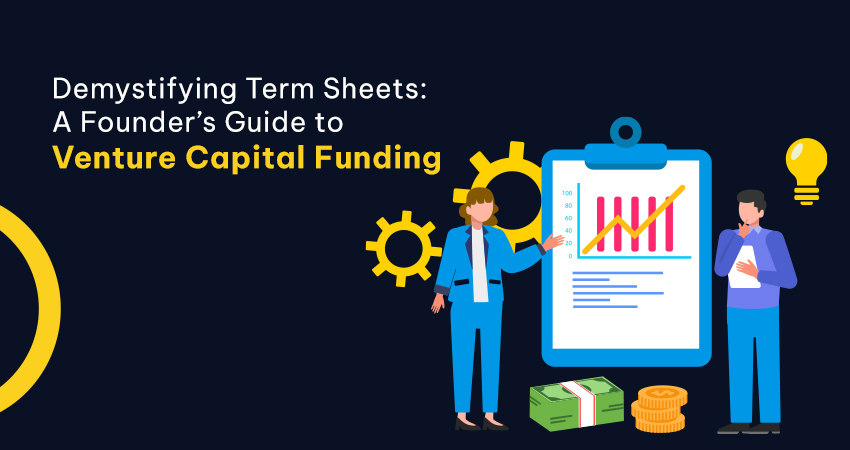
Demystifying Term Sheets: A Founder’s Guide to Venture Capital Funding
So, you’ve finally snagged that first meeting with a Venture Capitalist, nailed the pitch, and an email lands in your inbox with the subject line “Draft Term Sheet.” If your pulse quickens (equal parts excitement and panic), you’re in good company.
For most Indian founders, a term sheet feels like an overwhelming manuscript. Yet the document sets the rules of engagement for the money you’re about to raise, the control you’ll retain, and the exit you’ll eventually chase. Let’s unlayer the jargon and walk through what a term sheet says, why every clause matters, and how to negotiate one like a pro, without losing sleep or equity.
- What Exactly Is a Term Sheet?
Think of a term sheet as a marriage proposal before the wedding. It’s a non-binding snapshot of the economic and control terms investors want in exchange for their cheque; the fully binding wedding vows (the Share Subscription Agreement and Shareholders’ Agreement) come later.
Most sections are “subject to definitive documents,” but a few—confidentiality, exclusivity/no-shop, and governing law—are binding from day one. Skip the fine print at your peril.
- When Does It Arrive in the Fund-Raise Timeline?
- Pitch & initial interest
- Light due diligence (business model, traction, compliance)
- Term Sheet issued
- Detailed due diligence & negotiation
- Definitive documents signed
- Money in the bank (Closing)
A term sheet is not the finish line—it’s a starting point for diligence. Expect four to eight weeks between signing and seeing the funds in your account, assuming no obstacles stall your path to funding.
- The Economic Terms (Where The Money Lies)
a. Valuation & Price Per Share
- Pre-money vs. Post-money
Pre-money valuation refers to the value of your company before new capital is invested. Post-money valuation equals pre-money valuation plus the amount of the latest investment. It sounds simple, but mix-ups here can cost crores later.
- ESOP Pool Top-up
In India, Venture Capitalists often insist the Employee Stock Option pool sits post-money, effectively diluting only founders. Negotiate for a pre-money pool so everyone shares the love (and dilution).
b. The Instrument of Investment
Because of FEMA and FDI rules, Indian Venture Capital cheques usually come via:
| Instrument | Why Investors Like It | Regulatory Quirks |
| Equity Shares | Straightforward ownership and voting. | Must follow the RBI’s pricing guidelines. |
| CCPS (Compulsorily Convertible Preference Shares) | Priority payout (liquidation preference) + dividends. | FDI-compliant; conversion formula must be fixed. |
| CCD (Compulsorily Convertible Debentures) | Interest till conversion is tax-deductible for the company. | FEMA-approved but carries. debt-style covenants. |
| Convertible Notes (CN) | Popular in seed rounds; defer valuation fights. | Minimum ₹25 lakh per investor; must convert or repay within 10 years. |
c. Amount, Tranches & Milestones
Indian funds often release capital in two or three tranches tied to specific metrics, such as monthly Gross Merchandise Value (GMV), hiring milestones, or regulatory approvals. During market swings (such as the 2023 funding winter), ensure that milestones are measurable, founder-controlled, and realistic.
- The Control Terms: Who Holds the Steering Wheel?
- Board Composition
One seat for the lead investor is market standard; two is generous. To protect decision-making speed, push for an observer seat instead of a second voting seat.
- Reserved Matters
These are veto rights, such as Intellectual Property (IP) sales, large capital expenditures, and hiring the CEO’s cousin. Keep the list tight; too many consents and you’ll be WhatsApp-ing investors for permission for everything.
- Information Rights
Monthly management information systems (MIS), audited financial statements, and an annual budget are standard requests. Anything more granular—like weekly cash-flow statements—can be negotiated down.
- ESOP Pool
Size it realistically (10–15% pre-Series A is typical in India) and seek flexibility to “reload” without board veto when you experience hyper-growth.
- Binding Clauses Hidden in Plain Sight
- Exclusivity
Typically, it takes 30 to 60 days. Too long, and you’ll be grounded while other investors circle. Negotiate a short fuse or carve-outs for inbound strategic interest.
- Confidentiality
Mutual Non-disclosure Agreements (NDAs) are fine. Consider clauses restricting you from talking to other funds even after exclusivity expires.
- Governing Law & Dispute Resolution
Singapore-seated arbitration is gaining popularity, while many Indian VCs also opt for Mumbai or New Delhi. Choose a seat where the enforcement process suits your business needs the best.
- India-Specific Nuances Founders Often Miss
- FEMA Pricing Rules
For foreign investors, the share price can’t be below a floor price based on discounted cash flow or comparable listed multiples. This sometimes artificially inflates valuations—plan your down-round protections.
- Sector Caps & FDI Approval
Fintech, Telecom, and Defence companies often carry ownership caps or require government approval. Your term sheet should include a “regulatory tail-out” clause that allows both parties to walk away if approval stalls.
- Angel Tax & Section 56(2)(viib)
Valuation uplifts can trigger hefty tax unless you’re a Department for Promotion of Industry and Internal Trade (DPIIT) recognised startup. Include representations and warranties from investors to ensure fair-market pricing and avoid unexpected notices.
- Convertible Note Limits
Remember the ₹25 lakh minimum per investor and 10-year convert/repay cap—terms now codified in recent MCA and RBI circulars.
- Negotiating Like a Seasoned Founder
- Benchmark Against Market Data
Ask your friendly law firm for anonymised term-sheet comps or reference public guides from banks and law firms.
- Limit “Evergreen” Rights
Stacking anti-dilution across multiple rounds can bury your common shares. Request sunset clauses—rights expire after an IPO or 2–3 new rounds.
- Life After the Signature
- Confirmatory Due Diligence
Financials, IP ownership, employment contracts, pending litigation, Registrar of Companies (ROC) filings—expect deep dives. Clean up ESOP paperwork and GST filings now; it’s better than firefighting later.
- Definitive Docs
The Share Subscription Agreement covers the buy-in; the Shareholders’ Agreement embeds all those term-sheet clauses into legally enforceable obligations. Review each schedule closely—one misplaced comma on liquidation preference can cost crores.
- Regulatory Filings
Post-money, file Form PAS-3 for share allotment and FC-GPR if foreign funds were received. FEMA violations sting harder than valuation haircuts.
Raising capital in 2025 India isn’t just about valuations; it’s about picking partners who will stand by you through policy pivots, funding winters, and maybe the next pandemic. A fair term sheet is the first litmus test of that partnership. The right investor strikes a balance between downside protection and empowering the founder. Remember, your company’s biggest asset isn’t the capital you raise—it’s the vision and execution muscle you bring to the table.
A term sheet can feel intimidating, but with a clear playbook, it becomes a tool—your blueprint for scaling, protecting, and eventually exiting your startup on your terms. Read every clause, question every ambiguity, and never hesitate to push back on provisions that slow you down on your growth trajectory. . You owe it to yourself, your team, and the Indian startup ecosystem that’s rewriting global innovation one play at a time.
When that next “Draft Term Sheet” email pops up, you’ll open it with curiosity, not cold sweat. Happy negotiating, and here’s to building India’s next unicorn—on founder-friendly terms.

